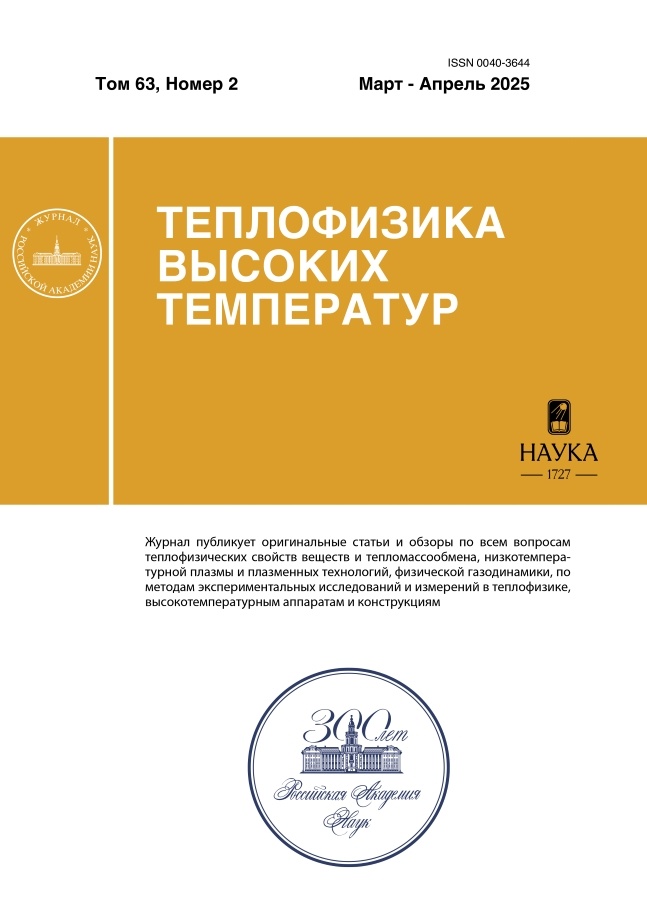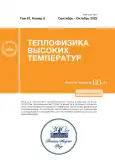Характеристики твердооксидного топливного элемента для термодинамического моделирования энергетических установок
- Авторы: Жук А.З.1, Иванов П.П.1
-
Учреждения:
- Объединенный институт высоких температур РАН
- Выпуск: Том 61, № 5 (2023)
- Страницы: 777-782
- Раздел: Новая энергетика и современные технологии
- URL: https://modernonco.orscience.ru/0040-3644/article/view/653081
- DOI: https://doi.org/10.31857/S0040364423050216
- ID: 653081
Цитировать
Полный текст
Аннотация
Определены термодинамические характеристики электрохимического процесса в твердооксидном топливном элементе с использованием физической модели, учитывающей внутреннюю конверсию метана. Эти характеристики могут быть полезным инструментом для исследования термодинамических циклов энергетических установок без физического расчета процессов в топливном элементе. В качестве исходных данных при их использовании служат коэффициент нагрузки и удельное поверхностное сопротивление мембранно-электродного узла.
Об авторах
А. З. Жук
Объединенный институт высоких температур РАН
Email: peter-p-ivanov@yandex.ru
Россия, Москва
П. П. Иванов
Объединенный институт высоких температур РАН
Автор, ответственный за переписку.
Email: peter-p-ivanov@yandex.ru
Россия, Москва
Список литературы
- Zhang X., Chan S.H., Li G., Hob H.K., Li J., Feng Z. A Review of Integration Strategies for Solid Oxide Fuel Cells // Journal of Power Sources. 2010. V. 195. P. 685.
- Glenk G., Reichelstein S. Reversible Power-to-gas Systems for Energy Conversion and Storage // Nature Commun. 2022. V. 13. 2010.
- Elharati M.A., Dewa M., Bkour Q., Hussain A.M., Miura Y., Dong S., Fukuyama Y., Dale N., Marin-Flores O.G., Ha S. Internal Reforming SOFC System Operating under Direct Ethanol Feed Condition // Energy Technology. 2020. V. 8. № 9. 2000350.
- Singh P., Hu B. Advanced Anode for Internal Reforming and Thermal Management in Solid Oxide Fuel Cells. Final Report, DE-FE-0031182. University of Connecticut, 2020.
- Dokmaingam P., Irvine J.T.S., Assabumrungrat S., Charojrochkul S., Laosiripojana N. Modeling of IT-SOFC with Indirect Internal Reforming Operation Fueled by Methane: Effect of Oxygen Adding as Autothermal Reforming // Int. J. Hydrogen Energy. 2010. V. 35. P. 13271.
- Иванов П.П. Термодинамическое моделирование энергетических установок с твердооксидным топливным элементом // ТВТ. 2011. Т. 49. № 4. С. 627.
- Hussain M.M., Li X., Dincer I. Mathematical Modeling of Planar Solid Oxide Fuel Cells // J. Power Sources. 2006. V. 161. P. 1012.
- Hussain M.M., Li X., Dincer I. A General Electrolyte-electrode-assembly Model for the Performance Characteristics of Planar Anode-supported Solid Oxide Fuel Cells // J. Power Sources. 2009. V. 189. P. 916.
- Zhu H., Kee R.J., Janardhanan V.M. et al. Modeling Elementary Heterogeneous Chemistry and Electrochemistry in Solid Oxide Fuel Cells // J. Electrochem. Soc. 2005. V. 152. P. A2427.
- Suwanwarangkul R., Croiset E., Entchev E. et al. Experimental and Modeling Study of Solid Oxide Fuel Cell Operating with Syngas Fuel // J. Power Sources. 2006. V. 161. P. 308.
- Sunde S. Simulations of Composite Electrodes in Fuel Cells // J. Electroceramics. 2000. V. 5(2). P. 153.
- Jiang Y., Virkar A.V. Fuel Composition and Diluent Effect on Gas Transport and Performance of Anode-Supported SOFCs // J. Electrochem. Soc. 2003. V. 150. P. A942.
- Жук А.З., Иванов П.П., Киселева Е.А. Моделирование электрохимического преобразования химической энергии биотоплива в электричество // ТВТ. 2020. Т. 58. № 2. С. 300.
Дополнительные файлы












